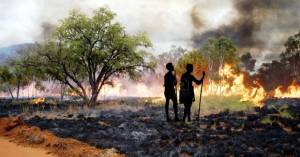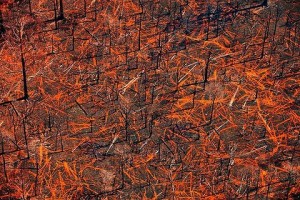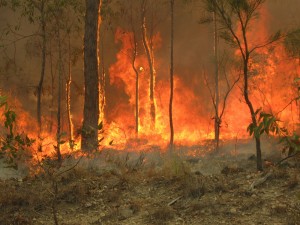As we reach the close of Inhuman Nature, we finally begin to gain a sense for what Nigel Clark’s radical project is trying to do. I see it as instilling a mode of sincerity, in which we must be really honest with ourselves, with what our ancestors have accomplished for us, and with what Earth can do and undo to the things we’ve built together. While initially Clark intimated a planet that was radically indifferent to human life – an inhumane nature – Clark seems to be refocusing this sense of complete non-agency to a balanced, restorative, and collaborative practice that is mindful of Bataille’s general economy, or all of the Earthly forces (cosmic even, with the Sun) that have enabled human civilizations, which now arguably shape the geologic patterns of Earth itself. While Clark initially intimated how these forces decimate human life at the blink of an eye, Chapter 7 “Burning for the Other: Colonial Encounters on a Planet of Fire” reframes one type of force that some have embraced, and others have tried to vanquish.
Clark wishes to examine our relationship with fire by drawing upon ancient fire histories, the ancestral Aboriginal Australians, early controlled fire practices in Western Europe, and the social control of fire (or fire practices). When white settlers first moved to the new lands of Australia, they were amazed to see indigenous peoples’ “ease and dexterity with fire,” utilizing various techniques to fight fire with fire. “The white expended the energy of panic; the blacks acted in familiarity, as knowing how and what to do. They used arm action only, where the white man used his whole body … The aboriginals said that not only must fire be met by fire, but that it could only be fought while still not too hot” (cited in Clark, p. 166). Here, Clark quotes the essayist Mary Gilmore, who spent her childhood in New South Wales (a state on the East coast of Australia) and witnessed the incredible, actionable knowledge the darker-skinned locals drew upon. Clark later suggests that this keen intuition develops at a young age, when Aboriginal children can “learn their respect for fire through playing with it” (Clark, p. 187). He contrasts this with Gaston Bachelard’s notion that because European children are prohibited from playing with fire, they lack this ‘playfulness’ that is necessary to engage with fire, leading to “a repression ‘which leave(s) little room for the acquiring of an unprejudiced knowledge” (Clark, p. 187).
Playfulness may allow children to become sensitized to fire at a young age, but it is generations of indigenous fire experimentation that Clark argues made the Aboriginals such astute controllers of this force. Looking at the fossil record for indications of wildfires in Australia over the last ten thousand years, Clark indicates that around 5,700 years ago there was “dramatic spike in the graph of charcoal deposits” which is the “signature of irrupting wild fire” (p. 169). These sediments suggest “wildfire of a scale and ferocity that could only have come as a shock to those who had experienced thousands of years of much less intense El Nino events,” yet around 3,000 years ago, despite there not being a major shift in the atmosphere system ENSO (El Nino Southern Oscillation), these large scale wildfires suddenly gave way to “smaller and more numerous low-intensity burns.” Since there was no natural explanation for this division into smaller fires, Clark suggests that the Aboriginal land management strategies had developed into a more sophisticated network of burning that was able to mitigate this period of deadly wet-dry fluctuations. Australian Aboriginals were not only playing with fire at a young age, but they had also been doing so for thousands of years.
Stephen Pyne believes that massive strategies of fire prevention, in which wildfires are not permitted to spread in regions where they occur naturally, is actually counter-productive to proliferating biodiversity. Additionally, Clark and Pyne argue that fire co-developed with the biosphere and actually helped to engender rich new worlds: “it is life itself which generated the conditions that render the earth uniquely conducive to fire” (p. 171). Oxygen was a by-product of photosynthesis from marine phytoplankton, carbon fuels were the result of plant life, and as a result of these stabilized atmospheric oxygen levels and thermodynamic processes like lightning and volcanism, fire and vegetation evolved together to shape the ecological systems of the Earth. There are also studies that suggest that the biodiversity we value so highly in tropical areas today were also enabled by this conflagration.
The indigenous knowledge of fire we looked at earlier was not solely existent in major wildfire areas like Australia, but for a period of time, Europeans also had land management practices that incorporated intentionally set fires. “These [fire practices] were all variants of shifting cultivation, in which cropping and animal foraging briefly took advantage of the ash-enriched soil before moving on to freshly fired clearings” (p. 176). Eventually, this mode of constantly shifting plots of agriculture led to a fixed field rotation system known as fallow. Rather than seeking new plots of enriched soils (caused by fires), farmers began to incorporate fire directly by letting vegetation accumulate until they were burnt for “the next round of sowing and reaping” (p. 177).
This vital part of ‘rural folk culture’ in Europe eventually suffered from city-educated agricultural experts who saw fire as an “expression of social unrest or breakdown, a mark of excess and disorder” (p. 177). These “Enlightenment agronomists set about closing the loops of agricultural production,” thereby locking Bataille’s general economy from a glorified state of energy from the sun to a closed system that could be more ‘rationally’ controlled. As Clark writes, “If the practice of fallow came to appear as a glitch in the strict cyclicality of Nature’s economy, fallow that went up in smoke was an unconscionable waste” (p. 177).
This ‘closing’ of our agricultural system to fire led, however, to incorporating a different form of untapped energy into farming: fossil fuels. Pumped into the closed circuits of agriculture to be used as extra energy and fertilizer, we were effectively tapping into a different type of general economy: the accumulation of biomass from millions of years. With Enlightenment science and technology in their corner, as well as a generally wet climate that did not proliferate as many wildfires as drier areas, Europeans were poised to lead a fire-free existence – until the early European settlers moved to Australia.
“…the fires of the dark child of the forest have cleared the soil, the hills and the valleys of the superabundant scrub and timber that covered the country and presented a bar to its occupation. Now, prepared by the hands of the lowest race in the scale of humanity … the soil of these extensive regions is ready to receive the virgin impressions of civilized man…” (cited in Clark, p. 185)
Clark here quotes Joseph Byrne, who in 1848 addressed the invaluable knowledge and practices of the Aboriginal Australians that allowed white European settlers to build and setup their colonies. These ‘nomadic scientists’ may be, or represent, some sort of key for adapting to changing climates, and even larger than that, changing worlds. The Aboriginals’ use of fire, in some respects, is a ‘world that worlds worlds’ – it is a mode of engaging with the environment, acknowledging that it is entirely indifferent to whether you live or not, but that you still possess an ability (and even responsibility) to learn how to exist with it.
In showing the generational extent required to learn how to channel fire (and even then, only to a degree), Clark wonders how our Western scientific system can be augmented by the knowledge one can only gain through swift adaptive intuition and on-the-ground experience. If Bataille conceived of an economy that deemed the Sun to be a generous entity whose gifts were incalculable, how could we conceptualize ourselves as a ‘generous force’ that gives back to the world, somehow transcending this for-us mentality? While Clark seemed to initially wish to remind us of our puny, mortal existence, he now firmly places us as stewards that inherit from an ambivalent past. Yes, Kant perhaps led us to perceiving Nature as ‘other’, but he himself was reminded of his finite existence by a natural catastrophe.
Clark, in dialogue with speculative philosophy, now hopes that we perceive this ‘other’ as not solely destructive (and indeed this would be unfair since we ourselves have become a geologic force), but rather an opportunity to be really honest with ourselves in what we have become, which requires truly acknowledging our inheritance from humans and nonhumans. It is here that Clark converges with Latour in his “insistence that our humanity, our communities and our bodies are an amalgam of more-than-human ingredients” (p. 192). While previously I had conflated inhuman nature with inhumane nature, I believe Clark is onto something more deeply hybrid than Latour: just as man-made fire fosters biodiversity, even inhuman nature, or the indifferent force that Clark initially instilled in us, is intertwined and shaped by human beings.



Howdy! I know this is kind of off topic but I was wondering which blog platform are you using
for this site? I’m getting tired of WordPress because I’ve had problems with hackers
and I’m looking at alternatives for another platform.
I would be fantastic if you could point me in the direction of a good platform.